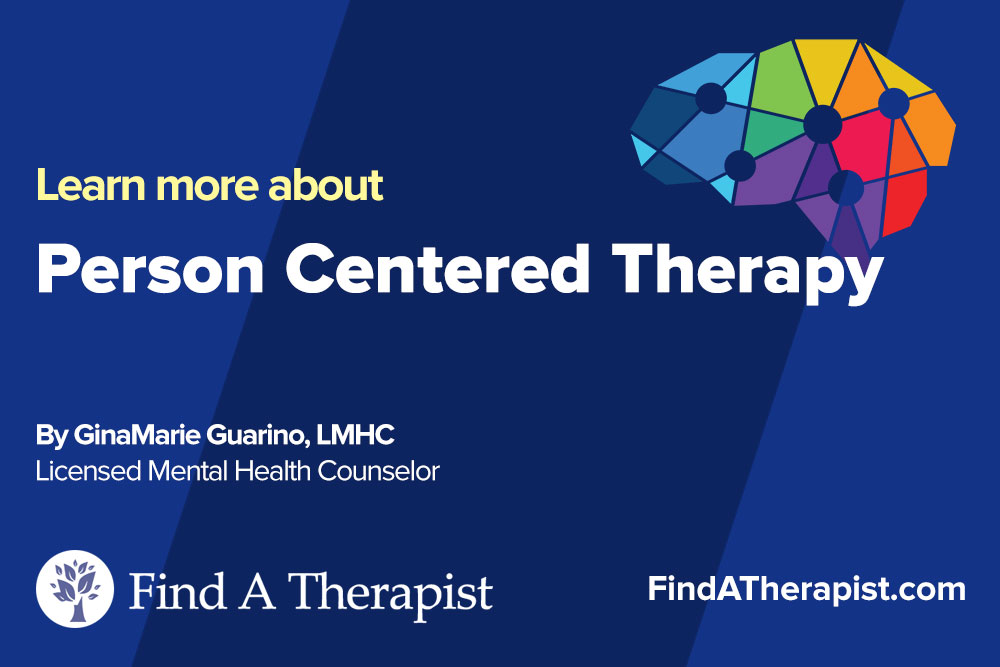Person Centered Therapy
Published on December 3rd, 2020
Updated on January 2nd, 2024

Contents
Person centered therapy is a therapeutic approach that was developed by Carl Rogers. Carl Rogers was an American clinical psychologist. He is also a founder of humanistic psychology.
Carl Rogers believed that therapy could be helpful when the therapeutic approach is non-directive. This means that the therapist facilitates the session. However, they are more of a passenger than a leader in the client’s journey. With person centered therapy, the client is the leader of the conversation. The client is given time and space to explore and work through their own thoughts and feelings.
Sponsored by

Choose a therapist to work with and start healing with 20% off from BetterHelp.
Click HereThe role of the therapist is not to interpret or guide the client. It is only to keep the client on the path of self-reflection. They do this through empathizing and asking guided questions.
Person centered therapy may also be referred to as client-centered therapy. A person who is engaging in person centered therapy is given the time and space to write their story. The direction of conversation in therapy depends on where the client wants to go. It does not depend on where the therapist feels the conversation should lead. With this approach, the client is empowered to keep control. They lead the way in their own self-discovery.
Self-Actualization And The Role Of The Therapist
In person centered therapy, the goal of the therapist is to help the client reach self-actualization. Self-actualization is a sense of fulfillment for one’s own potential. Everyone has potential to reach their own goals for who they are and who they want to be. Oftentimes, clients can struggle with reaching self-actualization.
Not everyone is able to reach a state of full self-actualization. However, with person centered therapy, they can close the gap between who they are and who they want to be. With this journey, a client can reach satisfaction with himself or herself.
To promote self-actualization, a therapist must use skills needed for person centered therapy. The intention of a person centered therapist is to develop an understanding for the client’s self-image. They seek to understand who their client is and their own journey. The therapist works hard to relate to the client’s experience. This process is led through developing empathy.
Empathy
A key skill a person centered therapist must use in sessions is empathy. Empathy is the ability to relate to another person’s experience on a personal level. To empathize, a person must be able to understand the challenges of a situation. They must also understand how a person thinks and feels in reaction to that challenge.
During a therapy session, a person centered therapist will aim to understand the client. They will look at the following in reaction to client’s present experiences:
- Thoughts
- Feelings
- Behaviors
According to Rogers, empathy is a key component to person centered therapy. Rogers recognized that the ability to empathize is important for any relationship. This includes therapeutic relationships.
Empathy plays an important part of how we relate to other people. Feeling empathy for the client allows therapists to step into their client’s world. They learn how to understand what shapes their client. They also understand how they have gotten to the point they are in with regard to their current lives.
An important part of empathy is the skill of developing understanding. This must be done while withholding judgment. Without judgment, empathic listening allows the therapist to understand a client. They learn how each part of their client’s self is connected. This is not to imply that the therapist must agree with the client’s beliefs, however.
A key part of mastering empathy is to be able to understand without feeling the impulse to:
- Draw conclusions
- Judge
- Agree
- Disagree
This is an important point. Each of these behaviors will blur the understanding of the client. This in turn, would hinder the therapeutic process for person centered therapy.
Reflective Listening
Therapists are best able to express empathy for their client through reflective listening. Reflective listening is listening to a client with the intention of understanding. A therapist using reflective listening will not listen to ask a follow-up question. They will also not try to formulate an insightful response.
Typically, most of what a person centered therapist will say during a session is an empathic reflection of what the client has shared. Sometimes there may be a guided question from the therapist. Otherwise, they will mostly facilitate conversation through means of reflective listening. This prevents the client from leading the conversation in any direction.
Reflective listening also prevents the therapist from becoming an authority figure during sessions. They remain a passenger in the client’s journey. Both therapist and client are considered equal members of the therapeutic relationship.
Through the practice of reflective listening, the therapist is able to be immersed in the client’s world. They learn how the client sees themselves in relation to the world around them. The client is allowed to remain the expert of their life, which helps them feel empowered during the therapeutic process. Along with using both empathy and reflective listening, the therapist also will use the process of congruence.
Congruence
Congruence is the ability to be authentic with a client during therapy sessions. The ability to remain authentic with a client promotes a healthy relationship between therapist and client. It allows for strong rapport to be built between the two individuals.
In order to be congruent, a therapist must open themselves up to feeling what the client feels during the therapy session. The ability to open up allows the therapist to feel more connected to the client in the present moment of the session. Through the connectedness, they are able to understand the client’s experiences and feelings. This promotes tolerance and unconditional positive regard. It also reduces the pressure to problem solve for the client or provide insight or point of view that the client may not be open to hearing.
Unconditional Positive Regard
Along with empathy, congruence and reflective listening, person centered therapy involves unconditional positive regard. Unconditional positive regard is the therapist’s ability to be unconditionally accepting. They are accepting of what a client is thinking and feeling. When a therapist uses unconditional positive regard, they accept what the client thinks and feels. There are no conditions that come with this acceptance. Each thought and feeling that the client expresses is valid during the session. There is no judgment, and there is no condition to being heard and embraced.
Unconditional positive regard is a powerful component during sessions. To express unconditional positive regard, a therapist must be aware of their own language. Both verbal and nonverbal language is important for a person centered therapist. Expressing empathy and understanding can be done with words and with body language. Because of this, a person centered therapist must be mindful of ways they communicate.
The Ideal Self
Person centered therapy is performed with the ideal self in mind. The goal of person centered therapy is to reach a point of self-actualization. In order to reach self-actualization, the gap between the self-concept and the ideal self must be closed as much as possible. Self-actualization is achievable. However, it is not achieved by all who participate in person centered therapy. While not everyone achieves self-actualization, the journey can help with understanding ideal self.
The ideal self refers to who a person wants to be. It reflects positive qualities a client desires but lacks while in therapy. Lacking qualities a person wishes they had creates a gap between:
- The way a person sees themselves
- Their ideal self
This gap often causes uncomfortable thoughts and beliefs about themselves. This can create negative thoughts and low self-esteem.
It is challenging for clients to embrace who they are when it is different than their ideal self. Negative thoughts about themselves affect their sense of self-value. While in person centered therapy, a client learns how to challenge their own negative self-talk. This in turn, helps them challenge their low self-esteem. It also helps them come to terms with their self-concept.
Self-Concept
Self-concept is a term often heard in person centered therapy. It refers to how a person sees themselves. Self-concept refers to people’s perceptions of who they are and how they fit into the world. It affects many areas of a person’s daily life. It affects how a person sees themselves. It also affects how they see their existence in relation to the world around them.
Self-concept is developed through life experiences. It is based on their own impression of who they are and what they are worth. It is formed by drawing conclusions of their own perceptions about life. It is subjective, which means it is based on how a person interacts and fits in with their own environment.
A person’s self-concept can be stubborn. Once it is formed, it can be difficult to change. It affects a person’s self-awareness and their beliefs about themselves. Once a person develops their self-concept, they see themselves through that image. They may reject positive information about themselves. This includes any information that challenges their beliefs about who they are. This is especially true for people who struggle with low self-esteem.
Self-concept has two key components. Those key components are self-esteem and self-image. Both of these components play critical roles in the development of self-concept. They are powerful, and can affect how a person sees themselves, the world and the future.
Self-Esteem
Self-esteem is the way we feel about ourselves. It is our own feeling of self-worth, and the level of respect we have for ourselves. Our self-esteem has a major impact on how we feel about who we are. It also has an impact on how we live our day to day lives.
With healthy self-esteem, a person is at peace with who they are. They understand that they have faults and challenges in their own life, but they feel good about themselves overall. In person centered therapy, having healthy self-esteem can make a difference in a person’s self-view. Even if their self-concept does not meet their ideal self, healthy self-esteem can make a huge difference on overall mood. People with healthy self-esteem have a healthy outlook on life.
People in therapy tend to have low self-esteem. This low self-esteem can cause a person to have negative thoughts and unhealthy beliefs about themselves. Low self-esteem can cause anxiety and depression. It can also have a negative effect on relationships, career goals, and overall outlook on life.
Having a high self-esteem can also be detrimental to a person’s mental health. It is considered a good thing to have high self-esteem, but if your self-esteem is too high it can impact your judgment. High sense of self-esteem can cause an inflated sense of self-importance. It can cause grandiose thoughts, and result in narcissistic behavior. Such high self-esteem can be damaging to mental health, relationships and life goals. It can also damage a person’s ability to relate to others and express empathy. A grandiose sense of self-esteem can even cause narcissistic personality disorder. People who are in therapy with self-esteem that is too high are often being treated for this condition.
Self-Image
The term ‘self-image’ refers to a person’s impression of themselves. It is an internal understanding of who a person is and what shapes their character. When reflecting on self-image, a person will identify characteristics that they feel apply to them. They may use adjectives and character traits to describe themselves. A self-image also consists of a collection of strengths and weaknesses that a person feels they have.
Self-image has a significant impact on how a person behaves. It will affect their internal dialog, and how they relate to others. People with a healthy self-image will be able to identify both their strengths and weaknesses. They will have a healthy perspective of these strengths and weaknesses, and learn how to optimize their strengths while embracing and forgiving their weaknesses. People who have unhealthy self-image may have an inaccurate view of their strengths and weaknesses. They may inflate things they do not like about themselves, or ignore the strengths they have.
Self-image significantly impacts a person’s self-esteem. Self-image creates the blueprint for self-esteem to be created. If a person has a healthy and balanced self-image, they are more likely to have healthy self-esteem. A person with a poor self-image is likely to have low self-esteem.
Sponsored by

Find an affordable therapist online with 20% off from BetterHelp.
Click Here






Leave A Reply